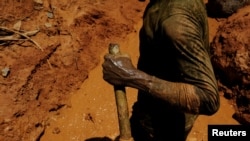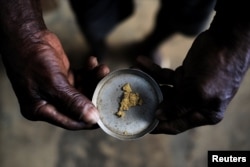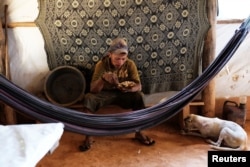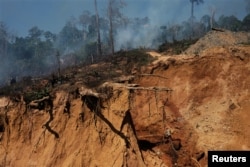Informal mining in Brazil is seen by many as a scourge polluting the Amazon rainforest, poisoning indigenous tribes and robbing the nation of its wealth.
For others it is a way of life.
Brazilian garimpos, or wildcat mines, are operated by small crews of men, often caked in red-brown mud and working with rudimentary pans, shovels and sluice boxes that have been used for centuries.
More sophisticated operations use water cannons and boats sucking mud from the bottoms of rivers. Regardless of the method, searching for gold and other minerals like cassiterite and niobium is dirty, dangerous and often illegal.
“Looking for gold is like playing in a casino,” said a 48-year-old miner.
Miners asked not to be named, saying they feared the police as much of their work is illegal.
Started as a teen
He started in the wildcat mines as a teenager in the area around Crepurizao, a ramshackle frontier town of 5,000 with a dirt landing strip that is a gateway for informal mining in the region.
Garimpos are in the spotlight as Brazil debates opening an area known as Renca in the northern Amazon forest to mining, which has met with stiff resistance from environmentalists.
Mines and Energy Minister Fernando Coelho Filho argues that licensed mining will be an improvement over the estimated 1,000 people currently mining in the reserve illegally.
Crepurizao lies hundreds of miles south of Renca, but gives a window into life in the garimpos caught up in the debate.
On brink of poverty
Living in makeshift homes of wood and plastic, miners in the area ship some 60 kilograms (132 lbs) of gold per month, according to traders.
That much pure gold is worth millions of dollars on the global market, but high costs and layers of traders in the local market leave most miners living on the brink of poverty.
Basic staples can cost four or five times the price in the nearest city, an eight-hour bus ride away.
Fuel stations, a general store, a bar, an evangelical church and prostitutes vie for the income and attention of the miners, known as garimpeiros, when they aren't working or lazing in hammocks.
Most unlicensed
There are 2,113 licensed garimpo sites in Brazil, according to ministry data, but environmental experts and two government officials, who asked not to be named, said far more small-scale mines skip the licensing and ignore regulations altogether.
In Crepurizao, where mines often cluster close together, it was unclear which operations were licensed.
The total area worked by garimpeiros in Brazil is thought to be small. But chemicals like mercury, which miners in Crepurizao dump to separate gold from grit, can leave a large footprint of contamination.
In March last year, a government-backed study of indigenous villages in the northern state of Roraima revealed alarming levels of mercury.
One group of villagers had more than double the level of mercury considered to be a serious health risk — such as damage to the central nervous system, kidneys, heart and reproductive process — detected in their hair.
New oversight
The Mining and Energy Ministry said a new oversight agency created in a decree by President Michel Temer, now pending congressional approval, would allow more effective government coordination and inspections to restrict illegal mining.
Congressman Leonardo Quintao, who sits on the committee considering the new agency, said it will be able to raise more funding for oversight. He said the regulations target licensed miners, while illegal mining remains a matter for the police.
Still, one enforcement officer, who was not authorized to speak to the media, said the government had left miners like those in Crepurizao in a precarious limbo.
“You can't just pull them out of the garimpos and the cities that are living off gold. And the government does not offer them structure and decent conditions,” said the officer. “So they're stranded there without the minimum conditions for survival.”




